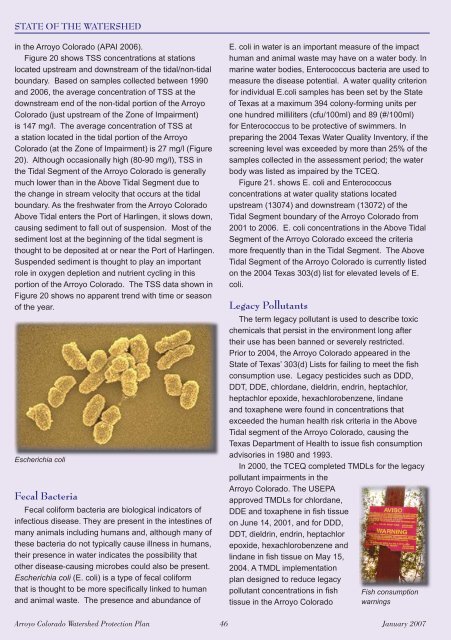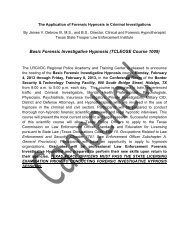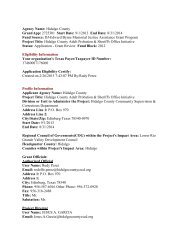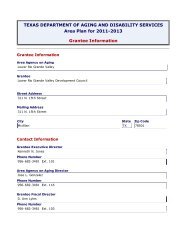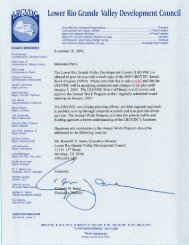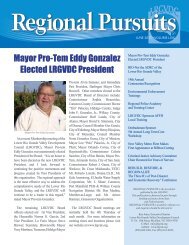Watershed Protection Plan - Lower Rio Grande Valley Development ...
Watershed Protection Plan - Lower Rio Grande Valley Development ...
Watershed Protection Plan - Lower Rio Grande Valley Development ...
You also want an ePaper? Increase the reach of your titles
YUMPU automatically turns print PDFs into web optimized ePapers that Google loves.
STATE OF THE WATERSHED<br />
in the Arroyo Colorado (APAI 2006).<br />
Figure 20 shows TSS concentrations at stations<br />
located upstream and downstream of the tidal/non-tidal<br />
boundary. Based on samples collected between 1990<br />
and 2006, the average concentration of TSS at the<br />
downstream end of the non-tidal portion of the Arroyo<br />
Colorado (just upstream of the Zone of Impairment)<br />
is 147 mg/l. The average concentration of TSS at<br />
a station located in the tidal portion of the Arroyo<br />
Colorado (at the Zone of Impairment) is 27 mg/l (Figure<br />
20). Although occasionally high (80-90 mg/l), TSS in<br />
the Tidal Segment of the Arroyo Colorado is generally<br />
much lower than in the Above Tidal Segment due to<br />
the change in stream velocity that occurs at the tidal<br />
boundary. As the freshwater from the Arroyo Colorado<br />
Above Tidal enters the Port of Harlingen, it slows down,<br />
causing sediment to fall out of suspension. Most of the<br />
sediment lost at the beginning of the tidal segment is<br />
thought to be deposited at or near the Port of Harlingen.<br />
Suspended sediment is thought to play an important<br />
role in oxygen depletion and nutrient cycling in this<br />
portion of the Arroyo Colorado. The TSS data shown in<br />
Figure 20 shows no apparent trend with time or season<br />
of the year.<br />
Escherichia coli<br />
Fecal Bacteria<br />
Fecal coliform bacteria are biological indicators of<br />
infectious disease. They are present in the intestines of<br />
many animals including humans and, although many of<br />
these bacteria do not typically cause illness in humans,<br />
their presence in water indicates the possibility that<br />
other disease-causing microbes could also be present.<br />
Escherichia coli (E. coli) is a type of fecal coliform<br />
that is thought to be more specifi cally linked to human<br />
and animal waste. The presence and abundance of<br />
E. coli in water is an important measure of the impact<br />
human and animal waste may have on a water body. In<br />
marine water bodies, Enterococcus bacteria are used to<br />
measure the disease potential. A water quality criterion<br />
for individual E.coli samples has been set by the State<br />
of Texas at a maximum 394 colony-forming units per<br />
one hundred milliliters (cfu/100ml) and 89 (#/100ml)<br />
for Enterococcus to be protective of swimmers. In<br />
preparing the 2004 Texas Water Quality Inventory, if the<br />
screening level was exceeded by more than 25% of the<br />
samples collected in the assessment period; the water<br />
body was listed as impaired by the TCEQ.<br />
Figure 21. shows E. coli and Enterococcus<br />
concentrations at water quality stations located<br />
upstream (13074) and downstream (13072) of the<br />
Tidal Segment boundary of the Arroyo Colorado from<br />
2001 to 2006. E. coli concentrations in the Above Tidal<br />
Segment of the Arroyo Colorado exceed the criteria<br />
more frequently than in the Tidal Segment. The Above<br />
Tidal Segment of the Arroyo Colorado is currently listed<br />
on the 2004 Texas 303(d) list for elevated levels of E.<br />
coli.<br />
Legacy Pollutants<br />
The term legacy pollutant is used to describe toxic<br />
chemicals that persist in the environment long after<br />
their use has been banned or severely restricted.<br />
Prior to 2004, the Arroyo Colorado appeared in the<br />
State of Texas’ 303(d) Lists for failing to meet the fi sh<br />
consumption use. Legacy pesticides such as DDD,<br />
DDT, DDE, chlordane, dieldrin, endrin, heptachlor,<br />
heptachlor epoxide, hexachlorobenzene, lindane<br />
and toxaphene were found in concentrations that<br />
exceeded the human health risk criteria in the Above<br />
Tidal segment of the Arroyo Colorado, causing the<br />
Texas Department of Health to issue fi sh consumption<br />
advisories in 1980 and 1993.<br />
In 2000, the TCEQ completed TMDLs for the legacy<br />
pollutant impairments in the<br />
Arroyo Colorado. The USEPA<br />
approved TMDLs for chlordane,<br />
DDE and toxaphene in fi sh tissue<br />
on June 14, 2001, and for DDD,<br />
DDT, dieldrin, endrin, heptachlor<br />
epoxide, hexachlorobenzene and<br />
lindane in fi sh tissue on May 15,<br />
2004. A TMDL implementation<br />
plan designed to reduce legacy<br />
pollutant concentrations in fi sh<br />
tissue in the Arroyo Colorado<br />
Fish consumption<br />
warnings<br />
Arroyo Colorado <strong>Watershed</strong> <strong>Protection</strong> <strong>Plan</strong> 46 January 2007


